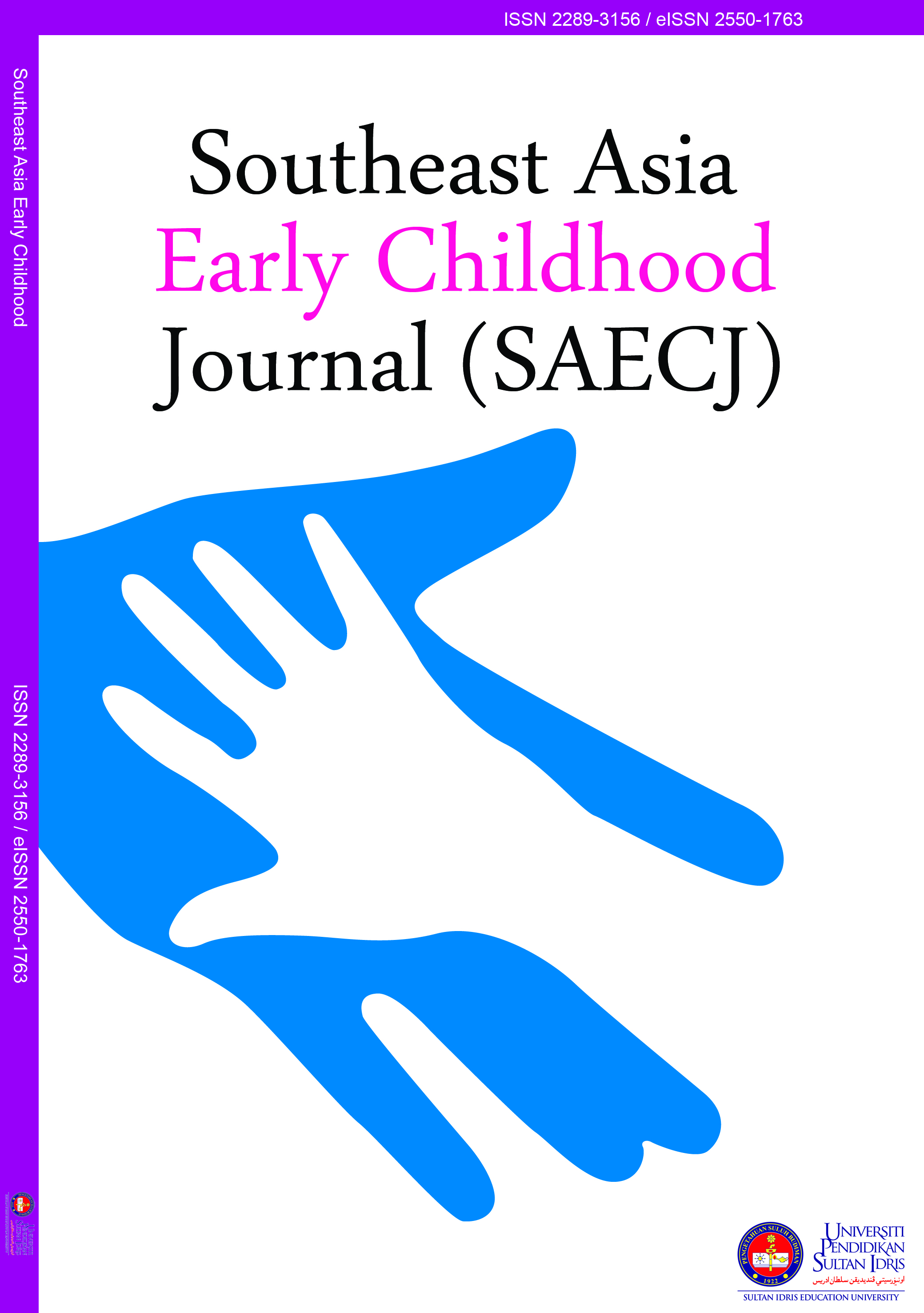Kekangan guru tadika untuk menerima kanak-kanak berkeperluan khas
The barriers faced by kindergarten teachers in accepting children with special needs
DOI:
https://doi.org/10.37134/saecj.vol9.no2.8.2020Keywords:
kekangan, guru tadika, kanak-kanak berkeperluan pendidikan khas, barriers, kindergarten teachers, special needs childrenAbstract
Tujuan kajian ini adalah untuk mengkaji kekangan yang dihadapi oleh guru tadika untuk menerima kanak-kanak berkeperluan pendidikan khas di dalam bilik darjah. Pendekatan secara kuantitatif digunakan dengan menggunakan kaedah tinjauan secara persampelan bukan rawak bagi memilih responden. Seramai n=77 orang guru tadika yang bertugas mengajar kanak-kanak sekitar umur lima hingga enam tahun di tadika. Analisis deskriptif menunjukkan tahap penilaian min adalah sederhana dan tinggi bagi pembolehubah kekangan guru tadika untuk menerima kanak-kanak berkeperluan pendidikan khas di tadika mereka dengan nilai sisihan piawai yang tinggi. Kajian ini diharapkan setiap tadika dapat menerima sepenuhnya kanak-kanak berkeperluan pendidikan khas tanpa sebarang bias sekaligus dapat mencapai matlamat Pelan Pembangunan Pendidikan Malaysia (PPPM) untuk melaksanakan pendidikan inklusif di dalam pendidikan awal kanak-kanak di Malaysia.
The study was aimed to investigate the barriers faced by kindergarten teachers in accepting children with special education needs classroom settings, as well as academic qualification that they received. A quantitative approach was adopted by using a survey with a non-random sampling. n=77 preschool teachers who were currently teaching five to six years old children in kindergartens were involved. Descriptive analysis explained that mean value was average to high for the variable barriers for teachers in accepting children with special needs. The study was hoped to imply on the acceptance of special needs children in private and public kindergartens is under consideration and following the rules and regulations. It is hoped that the aim of Blueprint for Educational Development Malaysia can be executed by implementing inclusive education in the early childhood education.
Downloads
References
Aminah, A., Rohani, A., Nani, M., & Jameyah, S. (2013). Modul Kursus Asuhan dan Didikan Awal Kanak-kanak Permata Negara. Penerbit Universiti Putra Malaysia.
Chhabra, S., Bose, K. & Chadha, N. (2018). Early childhood educators’ perspectives and practices about inclusion of children with special needs in Botswana. Journal of Research in Childhood Education, 32(2), 234-249,
Dimitrova-Radojchikj, D. & Chichevska-Jovanova, N. (2015). Teacher's acceptance of students with disability. Chemistry: Bulgarian Journal of Science Education, 24(5), 647-656.
Emam, M. M., & Mohamed, A. H. H. (2011). Preschool and primary school teachers' attitudes towards inclusive education in Egypt: The role of experience and self-efficacy. Procedia – Social and Behavioral Sciences, 29, 976 – 985.
Hirwan, J.J., Harlida A.W., & Nurli, Y. (2014). Hak bekerja orang kurang upaya: Satu tinjauan undang-undang di Malaysia. In: International Social Development Conference 2014 (ISDC 2014), Bayview Hotel Langkawi, Malaysia.
Ismail, H., Abdul, M. A., & Mohamad, I. (2019). The effect of Islamic visual art education on social development of preschool children. Jurnal Pendidikan Awal Kanak-Kanak Kebangsaan, 8, 1-7.
Jabatan Pendidikan Negeri Kedah. (2018). Slaid Kit Penerangan Pembelajaran Abad Ke-21 (PAK21). http://jpnkedah.moe.gov.my/index.php/28-hebahan-terkini/393-pembelajaran-abad-ke-21-pak21
Kahila, S. K., Heikka, J., & Sajaniemi, N. (2020). Teacher leadership in the context of early childhood education: Concepts, characteristics and enactment. Southeast Asia Early Childhood Journal, 9(1), 28-43.
Karande, S., Sholapurwala, R., & Kulkarni, R. (2011). Managing specific learning disability in schools in India. Indian Pediatrics, 48, 515-520.
Kementerian Pendidikan Malaysia. (2013). Pelan Pembangunan Pendidikan Malaysia 2013-2025. Bahagian Pendidikan Guru, Penulis.
Lee, F. L. M., Yeung, A. S., Tracey, D., & Barker, K. (2015). Inclusion of children with special needs in early childhood education: What teacher characteristics matter. Topics in Early Childhood Special Education, 35(2), 79-88.
Lopes, R. C. F., & Crenitte, P. A. P. (2013). Analytical study of teachers' knowledge about learning disorders. Revista CEFAC, 15(5), 1214-1226.
Mohd Najib, A.G. (1999). Kaedah penyelidikan pendidikan. (Edisi Kedua). Penerbitan Universiti Teknologi Malaysia.
Morrison, G. S. (2011). Early childhood education today (12th ed.). Pearson.
Norfishah, M.R. (2016). Transformasi pendidikan murid kurang upaya. Penerbit UPSI.
Othman, T. (2013). Asas penulisan tesis, penyelidikan & statistik. Universiti Putra Malaysia Press.
Safani, B., Nur Aishah, A., Noraini, A., & Mohd Hanafi, M. Y. (2016). Early intervention implementation preschool special education students in Malaysia. International Journal of Innovation Education and Research, 4(7), 130-155.
Smith, M. K., & Smith, K. E. (2014). “I believe in inclusion, but ….” Regular education early childhood teachers’ perceptions of successful inclusion. Journal of Research in Childhood Education, 14(2), 161–180.
Sugiyono. (2016). Metode penelitian kuantitatif, kualitatif dan R&D. PT Alfabet.
Syed Chear, S. L., & Md Yunus, M. (2019). Strategi penerapan kemahiran abad ke-21 dalam latihan guru prasekolah. Southeast Asia Early Childhood Journal, 8(1), 1-10.
Synodi, E. (2014). Children’s rights and the operation of Greek kindergartens. International Education Journal: Comparative Perspectives, 13(2), 60-72.
Wankel, C., & Stoner, J. A. (Eds.). (2009). Management education for global sustainability. IAP.
Zaini, Z. H., & Mansor, M. (2019). Persepsi guru prasekolah kebangsaan terhadap program pembangunan profesional guru. Southeast Asia Early Childhood Journal, 8(1), 30-36.
Zeenat, I., Ismat, B., Jehanzeb, H.K. (2016). Teachers' attitudes towards inclusion of special needs children into primary level mainstream schools in Karachi. The European Journal of Social & Behavioural Sciences, 17(3), 2177-2196.
Downloads
Published
Issue
Section
License
Copyright (c) 2020 UPSI Press

This work is licensed under a Creative Commons Attribution-NonCommercial-ShareAlike 4.0 International License.





